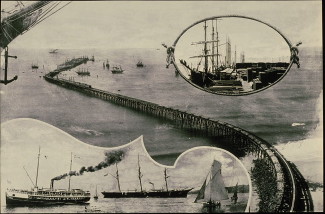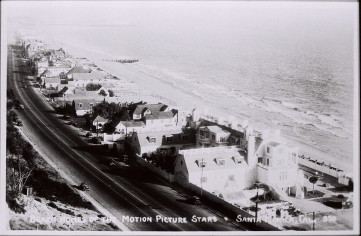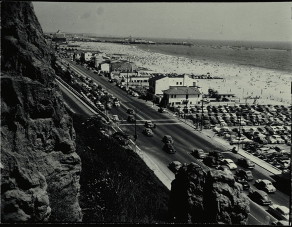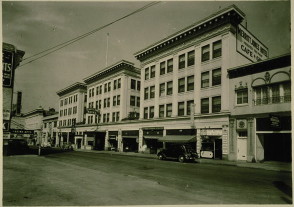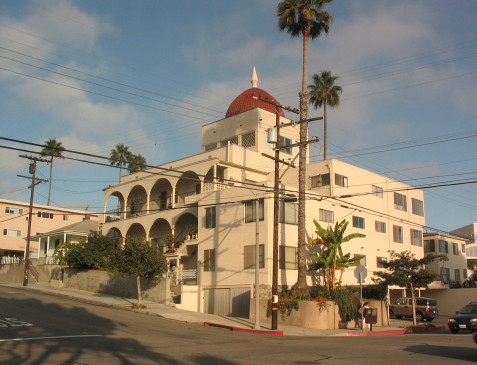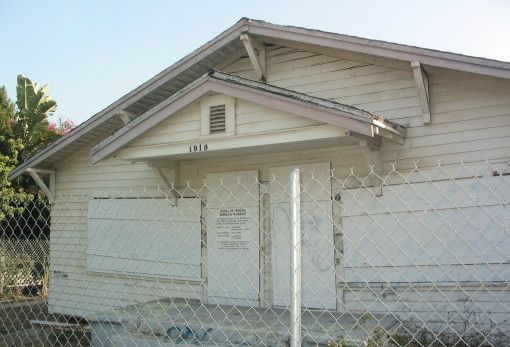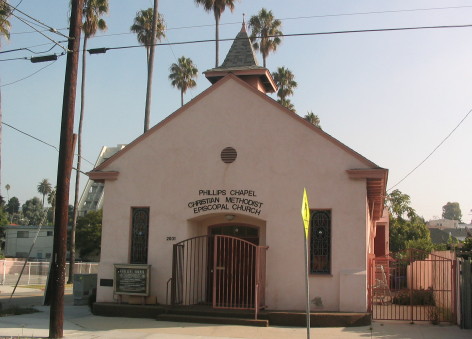| The LookOut columns |

|
What I Say | About
Frank Gruber Email Frank |
||||||||||||||
|
When More was Okay By Frank Gruber A week ago Saturday, at a workshop by the beach, the City and its outside designers unveiled preliminary plans to restore (in part) the old Marion Davies estate at 415 PCH. I attended the morning session of the workshop and that afternoon I heard historian Paula Scott (author of Santa Monica: A History on the Edge) give a short lecture on the history of Ocean Park at a meeting of the Ocean Park Association. Later in the week I attended a talk at USC by a graduate student in historic preservation about the history of Santa Monica's African-American community. So if I "don't know much about history" it's not for lack of trying. But before I consider the past, I'll take a moment to look toward the future, and say that the new plans for 415 PCH are more than encouraging in how they combine respect for what remains there of the Davies estate with a positive program of future use by the public. (Readers can get a look at the plans on-line.) The project's lead architect, Fred Fisher, began his presentation with photographs showing the history of the site, which showed how important this stretch of coastline has been for a long time. In about 150 years the coast has been through quite a few iterations of use. Contrary to the usual depressing narratives about lack of social progress and equity, the beach has become more accessible, not less. From 1893 to 1920 railroad tracks ran up the coast to the famous "Long Wharf."
Then the wealthy privatized the area as the "Gold Coast."
We rue the traffic that jams PCH on good beach days (and the sprawling development up the coast and in the Valley that has turned PCH into a jammed commuters' highway on weekdays, too), but it was the family car that democratized the coast beyond the trolley tracks.
Now, with money provided by the Annenberg Foundation, the remnants of Marion Davies' private estate on the beach will become a public beach club with facilities to rival those of nearby private clubs. The major point Paula Scott made in her talk about Ocean Park's history was what while Santa Monica's founder Senator John P. Jones built Santa Monica for commerce, Abbott Kinney (who named Ocean Park) based his plans for making money in the area south of the arroyo on the pleasure principle. North of the arroyo there was the Long Wharf; south of it, there were "pleasure piers." Along with the myth that the coast is less accessible than it was, there is also a myth that the beach is more developed and that Santa Monica is less a "beach town" than it was because of "over-development." Obviously, away from the beach Santa Monica never was a beach town; true to Senator Jones' vision, Santa Monica became an industrial center -- making everything from bricks to airplanes. But on the beach, there has been the opposite of over-development. If Santa Monica is less a beach town, it's because -- at least along the beach -- there is simply less town. The beach north of the Pier will never be as built up as it was during Gold Coast days, yet even more, Ocean Park is a shadow of what it was. Santa Monicans are familiar with photographs from the old days of Ocean Park showing packed piers with big roller coasters and "plunges" and other amusements, but even these photographs don't do justice to the dense commercial architecture that existed in the business district west of Main Street.
In the 1960's the City destroyed most of these buildings -- nearly everything west of Nielson (the old trolley route) and south of Ocean Park Boulevard -- to build the exclusively residential Ocean Park Redevelopment project. (If you have a taste for melancholy, go to the library's Image Archive and search on "Ocean Park Redevelopment," and gaze on what was lost. To learn more about all the businesses that once existed in the area, go to http://naid.sppsr.ucla.edu/venice/articles/Venicebusinesses.htm) You can see remnants of this era in buildings scattered through Ocean Park today -- solid apartment buildings, like the B.P.O.E. (a/k/a One Life) building at Main and Pier, or three and four story apartments like the one on Third Street, first built in 1907, that the wrestler Baron Leone later bought and expanded and called the "Baron's Castle."
In her 20 minute talk, historian Scott didn't have time to advance far into the 20th century, which was a shame because what puzzles me is how and why Ocean Park declined so precipitously -- to the point that by mid-century it became prey for the urban renewal monster. A couple weeks ago at the City Council hearing on the Opportunities and Challenges Report, one Ocean Parker with a memory back as far as the 1970's recalled when the neighborhood was considered a slum. When I moved to Ocean Park in 1983 every block seemed to have at least one abandoned house, and people tell me that in the mid-1970's Main Street was a skid row.
These days when everyone wants to live near the beach, it's hard to understand how this happened, but it's taken 30 years of steady investment to bring the neighborhood and Main Street back. One of the first investors in the neighborhood in the 1980's was Community Corporation of Santa Monica, which built subsidized affordable apartments; this is now ironic, because the neighborhood's big problem today, a consequence of success, is lack of affordable housing. My theory is that Ocean Park declined mid-century because of its heterogeneity, and that brings me to the talk Alison Jefferson, a graduate student in USC's historic preservation program, gave to a lunch-time colloquium at USC. Ms. Jefferson's talk was about the African-American community in Santa Monica, with particular emphasis on the history of "Phillips Chapel," the Christian (formerly "Colored") Methodist Episcopal (CME) Church at the corner of Fourth and Bay Streets.
Ms. Jefferson has nominated the church for landmark status in Santa Monica, a designation it surely deserves. While the architecture after a 1940's remodel is nothing special, the church has unique historical significance as the first CME church built in California -- way back in 1908. Although many blacks were driven from the vicinity when the City built the Civic Auditorium on top of an African-American residential and business district known as the Belmar Triangle, Ocean Park was -- and remains -- one of the few ethnically heterogeneous neighborhoods in Santa Monica, long after racial covenants limited people of color to the other side of Senator Jones' tracks. Ocean Park was also, and is still, architecturally diverse, with apartments next to single-family houses, and single-family houses that range from stately Victorians to modest beach bungalows crammed on tiny, now substandard, lots. As I said, my theory is that in the mid-century era that prized conformity and uniformity, as well as the new and modern, and at a time when banks and the Federal Housing Administration red-lined racially diverse neighborhoods, Ocean Park's multi-faceted heterogeneity doomed it to become, as the skateboarders in the 1970's described it, "where the debris hits the sea." But things that go around come around and today its heterogeneity is what makes Ocean Park important. Ocean Park has put to the lie the myths that families with choices will not choose to live in a mixed neighborhood, that they will not choose a house that is next to an apartment building, that they will not choose to live in a neighborhood with subsidized apartments, that they will not choose to live in a dense urban neighborhood. History hasn't stopped in Ocean Park -- it has returned. | ||||||||||||||||
| |
The
views expressed in this column are those of Frank Gruber and do not necessarily reflect the opinions of The Lookout. |
Copyright 1999-2008 surfsantamonica.com. All Rights Reserved. |
